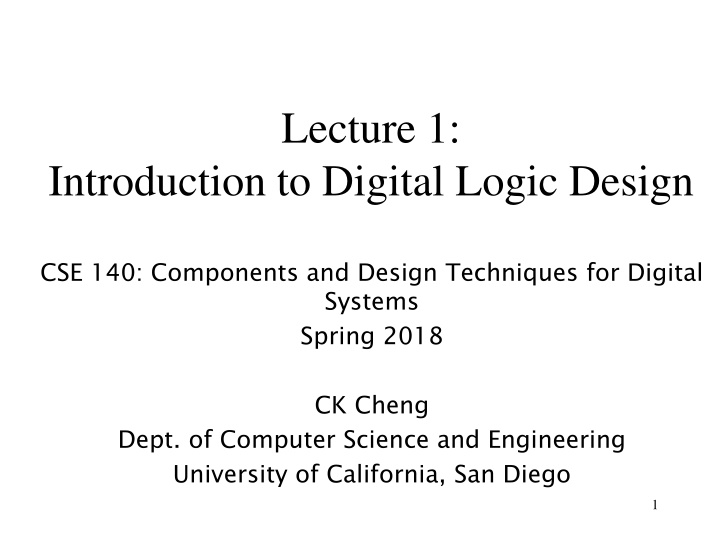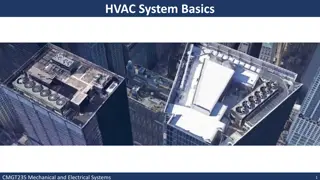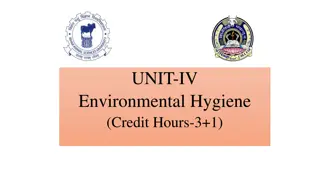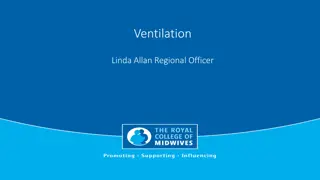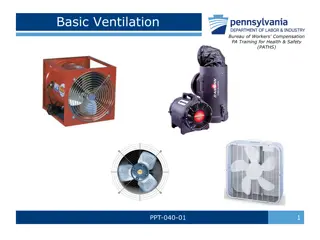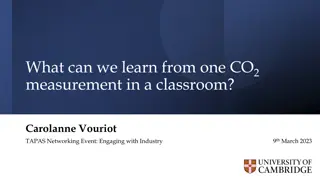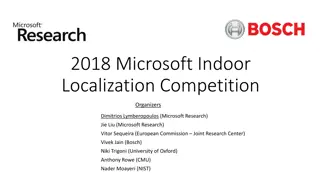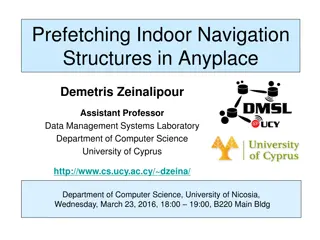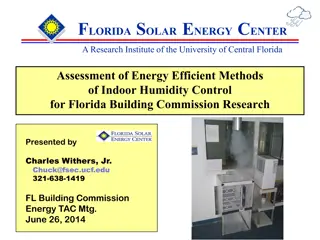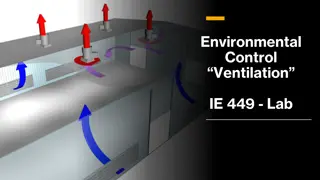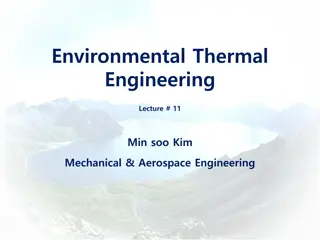HVAC Experts Summit: Indoor Air Quality and Ventilation Innovations
Assembling top experts such as Guangyu Cao, Claus Andreasson, Torben Sigsgaard, and Lars Ekberg in the HVAC industry to discuss adapting COVID-19 guidelines, control of indoor air humidity, room air cleaners, and more. Gain insights on cutting-edge research and practices shaping the future of indoor air quality management.
Download Presentation

Please find below an Image/Link to download the presentation.
The content on the website is provided AS IS for your information and personal use only. It may not be sold, licensed, or shared on other websites without obtaining consent from the author.If you encounter any issues during the download, it is possible that the publisher has removed the file from their server.
You are allowed to download the files provided on this website for personal or commercial use, subject to the condition that they are used lawfully. All files are the property of their respective owners.
The content on the website is provided AS IS for your information and personal use only. It may not be sold, licensed, or shared on other websites without obtaining consent from the author.
E N D
Presentation Transcript
Lecture 1: Introduction to Digital Logic Design CSE 140: Components and Design Techniques for Digital Systems Spring 2018 CK Cheng Dept. of Computer Science and Engineering University of California, San Diego 1
Outlines Class Schedule and Enrollment Staff Instructor, TAs, Tutors Logistics Websites, Textbooks, Grading Policy Motivation Moore s Law, Internet of Things, Quantum Computing Scope Position among courses Coverage 2
Class Schedule and Enrollment CSE140 A (enrollment 175, waitlist 48) Lecture: TR 5-620PM, SOLIS 107 Discussion: F 3-350PM, PCYNH 106 Final: S 3-5PM, 6/9/2018 CSE140 B (enrollment 146, waitlist 16) Lecture: TR 2-320PM Center 214 Discussion: F 4-450PM, PCYNH 106 Final: S 3-5PM, 6/6/2018 Waitlist: I welcome all students but have no control of the enrollment No discussion session on Friday 4/6/2018 3
Information about the Instructor Instructor: CK Cheng Education: Ph.D. in EECS UC Berkeley Industrial Experiences: Engineer of AMD, Mentor Graphics, Bellcore; Consultant for technology companies Email: ckcheng+140@ucsd.edu Office: Room 2130 CSE Building Office hours are posted on the course website 2-250PM Monday; 10-1050AM Friday Websites http://cseweb.ucsd.edu/~kuan http://cseweb.ucsd.edu/classes/sp18/cse140-a 4
Information about TAs and Tutors TAs Wang, Ariel Xinyuan email:xiw193@ucsd.edu Hsu, Po-Ya email:p8hsu@ucsd.edu Assare, Omid email:omid@ucsd.edu Tutors Yu, Yue 10hrs/week Deliwala, Ravish Ashish 10hrs/week Hu, Renxu 5hrs/week Lu, Anthony 20 hrs/week Kulshreshtha, Priyanka 10hrs/week Chen, Zhiran 10hrs/week Wang, Lan 10hrs/week Wang, Xinwei 10hrs/week Kum, Cheuk Him Deacon 10hrs/week Sim, Joonseop 5hrs/week Office hours will be posted on the course website 5
Logistics: Sites for the Class Class website http://cseweb.ucsd.edu/classes/sp18/cse140-a/index.html Index: Staff Contacts and Office Hrs Syllabus Grading policy Class notes Assignment: Homework and zyBook Activities Exercises: Solutions and Rubrics Forum (Piazza): Online Discussion *make sure you have access Score keepers: Gradescope, TritonEd ACMS Labs ieng6: BSV Bluespec System Verilog zyBook: UCSDCSE140ChengSpring2018 6
Logistics: Textbooks Required text: Online Textbook: Digital Design by F. Vahid 1. Sign in or create an account at learn.zybooks.com 2. Enter zyBook code UCSDCSE140ChengSpring2018 3. Fill email address with domain @ucsd.edu 4. Fill section A or B 5. Click Subscribe $54 Reference texts (recommended and reserved in library) Digital Design, F. Vahid, 2010 (2nd Edition). Digital Design and Computer Architecture, D.M. Harris and S.L. Harris, Morgan Kaufmann, 2015 (ARM Edition). Digital Systems and Hardware/Firmware Algorithms, Milos D. Ercegovac and Tomas Lang. 7
Lecture: iCliker for Peer Instruction I will pose questions. You will Solo vote: Think for yourself and select answer Discuss: Analyze problem in teams of three Practice analyzing, talking about challenging concepts Reach consensus Class wide discussion: Led by YOU (students) tell us what you talked about in discussion that everyone should know. Many questions are open, i.e. no exact solutions. Emphasis is on reasoning and team discussion No solution will be posted 8
Logistics: Grading Grade on style, completeness and correctness zyBook exercises: 10% (due Tuesday 2:00PM) iClicker: 10% (by participation up to 10 classes) Homework: 15% (grade based on a subset of problems) Midterm 1: 20% (T 4/24/18) Midterm 2: 20% (T 5/15/18) Final: 25% (3-5PM, Saturday 6/9/18) Grading: The best of the following The threshold: A- >90% ; B- >80% of 100% score The curve: (A+,A,A-) top 33 % of class; (B+,B,B-) second 33 % The bottom: C- above 45% of 100% score. 9
Logistic: grading components zyBook: Interactive learning experience No excuse for delay iClicker: Clarification of the concepts and team discussion Participation of 10 classes. No excuse for missing Homework: Paper Work Coding: BSV Bluespec System Verilog Group discussion is encouraged. However, we are required to write them individually for the best results Discount 10% loss of credit for each day after the deadline but no credit after the solution is posted. Metric: Posted solutions and rubrics, but not grading results 10
Logistic: Midterms and Final Midterms: (Another) Indication of how well we have absorbed the material Samples will be posted for more practices. Solution and grading policy will be posted after the exam. Midterm 2 is not cumulative but requires a good command of the Midterm 1 content. Final: Two hours exam. Samples will be posted for more practices. Final is not cumulative but requires a good command of the whole class. 11
Logistic: Class Expectation Level 1: Introduction (zyBook) Basic concepts Motivation Level 2: Essence (Lecture and slides) Key ideas Level 3: Hands on practice (Homework) Exercises Level 4: Samples of exams Review 12
Course ProblemsCheating What is cheating? Studying together in groups is not cheating but encouraged Turned-in work must be completely your own. Copying someone else s solution on a HW or Exam is cheating Both giver and receiver are equally culpable We will be better off to work on the problem alone during the exam. We have to address the issue once the cheating is reported by TAs or tutors. 13
Motivation Microelectronic technologies have revolutionized our world: cell phones, internet, rapid advances in medicine, etc. The semiconductor industry has grown from $21 billion in 1985 to $335 billion in 2015. 14
The Digital Revolution Integrated Circuit: Many digital operations on the same material Vacuum tubes Exponential Growth of Computation (1.6 x 11.1 mm) ENIAC Integrated Circuit Moore s Law Stored Program Model WWII 1949 1965 15
Building complex circuits Transistor 16
Robert Noyce, 1927 - 1990 Nicknamed Mayor of Silicon Valley Cofounded Fairchild Semiconductor in 1957 Cofounded Intel in 1968 Co-invented the integrated circuit 17
Gordon Moore Cofounded Intel in 1968 with Robert Noyce. Moore s Law: the number of transistors on a computer chip doubles every 1.5 years (observed in 1965) 18
Technology Trends: Moores Law Since 1975, transistor counts have doubled every two years. 19
New Technologies New materials and fabrication for devices Low power devices Three dimensional integrated circuits Graphene New architecture Machine learning, deep learning Quantum computing 20
Artificial Intelligence Logic and Reasoning Boolean Satisfiability Product of sum clauses Diagnosis States and Sequences Sequential Machines Reachability Controllability 21
Scope The purpose of this course is that we: Learn the principles of digital design Learn to systematically debug increasingly complex designs Design and build digital systems Learn what s under the hood of an electronic component Prepare for the future technology revolution 22
Position among CSE Courses Algos: CSE 100, 101 Application (ex: browser) CSE 120 CSE 131 Operating System (Mac OSX) Compiler Software Assembler Instruction Set Architecture Architecture CSE 141 Processor Memory I/O system Datapath & Control CSE 140 Digital Design Circuit Design Transistors Big idea: Coordination of many levels of abstraction Dan Garcia
Principle of Abstraction Application Software programs Operating Systems device drivers CSE 30 instructions registers Architecture focus of this course CSE 141 Micro- architecture datapaths controllers adders memories Logic CSE 140 Digital Circuits AND gates NOT gates Analog Circuits amplifiers filters Abstraction: Hiding details when they are not important transistors diodes Devices 24 Physics electrons
Combinational Logic vs Sequential Network x1 . . . xn x1 . . . xn xn x1 . . . fi(x,s) fi(x) fi(x) fi(x) fi(x) si CLK Sequential Networks 1. Memory 2. Time Steps (Clock) Combinational logic: yi = fi(x1,..,xn) yit = fi (x1t, ,xnt, s1t, ,smt) sit+1 = gi(x1t, ,xnt, s1t, ,smt) 25
Scope: Overall Picture of CS140 Control Subsystem Data Path Subsystem Input Memory File Conditions Pointer Select Sequential machine Mux ALU Control Memory Register CLK: Synchronizing Clock Conditions 26 BSV: Design specification and modular design methodology
Scope Subjects Building Blocks Theory Combinational Logic AND, OR, NOT, XOR Boolean Algebra Sequential Network AND, OR, NOT, FF Finite State Machine Standard Modules Operators, Interconnects, Memory Data Paths, Control Paths Arithmetics, Universal Logic System Design Methodologies 27
Combinational Logic Basics 28
What is a combinational circuit? No memory Realizes one or more functions Inputs and outputs can only have two discrete values Physical domain (usually, voltages) (Ground 0V, Vdd 1V) Mathematical domain : Boolean variables (True, False) Differentiate between different representations: physical circuit schematic diagram mathematical expressions 29
Boolean Algebra A branch of algebra in which the values of the variables belong to a set B (e.g. {0, 1}), has two operations {+, .} that satisfy the following four sets of laws. Associative laws: (a+b)+c= a+(b+c), (a b) c =a (b c) Commutative laws: a+b=b+a, a b=b a Distributive laws: a+(b c)=(a+b) (a+c), a (b+c)=a b+a c Identity laws: a+0=a, a 1=a Complement laws: a+a =1, a a =0 (x : the complement element of x) <30>
Representations of combinational circuits: The Schematic A Y B What is the simplest combinational circuit that you know? 31
Representations of combinational circuits Truth Table: Enumeration of all combinations Example: AND id 0 1 2 3 A 0 0 1 1 B 0 1 0 1 Y 0 0 0 1 A Y=AB B 32
Boolean Algebra Similar to regular algebra but defined on sets with only three basic logic operations: 1. Intersection: AND (2-input); 2. Union: OR (2-input); 3. Complement: NOT ( 1-input); Operator: ,& Operator: + ,| Operator: ,! &, |, ! Symbols in BSV <33>
Boolean algebra and switching functions One-input NOT (Complement, ) Two-input OR (+ ) Two-input AND ( ) AND OR A B Y A B Y NOT 0 0 0 0 1 1 1 0 1 1 1 1 A 1 A Y 0 0 0 0 1 0 1 0 0 1 1 1 A 1 0 1 1 0 A 1 A 0 A 0 0 A For an OR gate, 1 at input blocks the other inputs and dominates the output 0 at input passes signal A For an AND gate, 0 at input blocks the other inputs and dominates the output 1 at input passes signal A 34
Example: 35
Boolean Algebra iClicker Q: For two Boolean variables X and Y with X=1, Y=0, what is function F(X,Y)=X+Y? A.F(X,Y)=0 B.F(X,Y)=1 C.F(X,Y)=2 <36>
Boolean Algebra iClicker Q: For two Boolean variables X and Y with X=1, Y=0, what is function F(X,Y)=X+X+Y? A.F(X,Y)=0 B.F(X,Y)=1 C.F(X,Y)=2 <37>
Boolean Algebra iClicker Q: For two Boolean variables X and Y with X=1, Y=0, what is function F(X,Y)=X+XY? A.F(X,Y)=0 B.F(X,Y)=1 C.F(X,Y)=2 <38>
Boolean Algebra iClicker Q: For two Boolean variables X and Y with X=1, Y=0, what is function F(X,Y)=(X+Y)Y? A.F(X,Y)=0 B.F(X,Y)=1 C.F(X,Y)=2 <39>
So, what is the point of representing gates as symbols and Boolean expressions? Given the Boolean expression, we can draw the circuit it represents by cascading gates (and vice versa) ab a b ab + cd y=e (ab+cd) c d cd e Logic circuit vs. Boolean Algebra Expression 40
Next class Designing Combinational circuits 41
